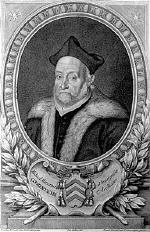Michele Mercati

Michele Mercati (born April 6, 1541 in San Miniato , † June 25, 1593 in Rome ) was an Italian polymath.
The son of a doctor was trained at the University of Pisa . His grandfather of the same name belonged to the Florentine humanist circle around Marsilio Ficino . The most important teacher was Andreas Caesalpinus . Mercati studied medicine and philosophy . He was also interested in natural history, mineralogy , paleontology and botany . During the reign of Popes Pius V , Gregory XIII. , Sixtus V and Clement VIII , he was now Apostolic Protonotary , as prefect responsible for the papal gardens. During the reign of Pius V, he created the Botanical Garden of the Vatican from the previously existing garden of medicinal plants. He wrote a book, the Museum of Stones, Metallotheca Vaticana , about his areas of interest, but it was not published until 1717. The illustrations for this were provided by the Paderborn engraver Antonius Eisenhoit , whom he sponsored and from whom he commissioned 130 engravings. Here he described the Vatican collection of "art and miracles".

Mercati collected, often as a travel companion of Cardinal Ippolito Aldobrandini (later Pope Clement VIII ), prehistoric stone tools, fossils and minerals . He was the first scientist to recognize stone tools as such , not least because of his classical education, his access to the Vatican Library and the Vatican Collection of artefacts from Asia and Africa. He was the first to describe flint arrowheads, stone axes and stone blades. His collection was considered the largest and most important of its kind, but went under after his death and can only be accessed through the catalog. The British archaeologist David Leonard Clarke put it on a par with Gerolamo Cardano for mathematics, Andreas Vesalius for anatomy, Galileo Galilei for physics and Nicolaus Copernicus for astronomy in terms of its importance for archeology . Mercati reported on ancient statues and their find circumstances and initiated the restoration of the Lateran Obelisk .
Works (selection)
- Michaelis Mercati Samminiatensis Metallotheca opus posthumum… opera autem, & studio Ioannis Mariae Lancisii . Rome 1717 ( sample pages )
- Appendix ad Metallothecam Vaticanam Michaelis Mercati . Rome 1719 ( title page )
- Michaelis Mercati Samminiatensis Metallotheca opus posthumum… Cui accessit appendix . Rome 1719 (online) at HathiTrust .
- De gli obelischi di Roma. Di monsig. Michele Mercati protonot. apostolico . In Roma: appresso Domenico Basa, 1589. ( digitized )
- Instruttione sopra la peste, di M. Michele Mercati medico e filosofo nella quale si contengono i piu eletti & approuati rimedij, con molti nuoui e potenti secreti cosi da preseruarsi come da curarsi. Aggiunteui tre altre instruttioni sopra i veleni occultamente ministrati podagra & paralisi .... In Roma: appresso Vincentio Accolto. 1576
literature
- Helmut Wilsdorf : Mercati, Michele , in: Lexicon of the Renaissance. Bibliographisches Institut, Leipzig 1989 ISBN 3-323-00268-7
- Elisa Andretta: Mercati, Michele. In: Mario Caravale (ed.): Dizionario Biografico degli Italiani (DBI). Volume 73: Meda-Messadaglia. Istituto della Enciclopedia Italiana, Rome 2009.
- Walter Freund: Anton Eisenhoit and Mercatis “Metallotheca”. in: Yearbook of the district of Höxter 1989, pp. 171–176.
Remarks
- ↑ David L. Clarke: Analytical Archeology. Routledge, London 1968, ISBN 0416854605 , p. 9.
- ^ Evidence in the SBN
- ↑ Proof in the Internet Culturale
- ↑ Proof in the Internet Culturale
Web links
- Petr Huber: Michele Mercati's (Michael Mercatus) Chamber of Art and Curiosities
- Michele Mercati on the Internet Culturale .
- Publications by Michel Mercati in the Opac des Servizio Bibliotecario Nazionale (SBN)
| personal data | |
|---|---|
| SURNAME | Mercati, Michele |
| BRIEF DESCRIPTION | Italian polymath |
| DATE OF BIRTH | April 6, 1541 |
| PLACE OF BIRTH | San Miniato |
| DATE OF DEATH | June 25, 1593 |
| Place of death | Rome |